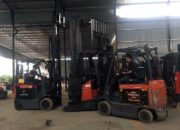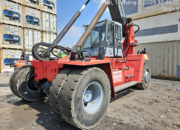Revealing 10 Ways to Optimize Forklift Performance in Logistics Environments
Did you know that forklifts play a critical role in the logistics industry, but operating them efficiently is always a challenging task? From selecting the right type of forklift, training professional staff, to regular maintenance and applying advanced technology, there are many factors that affect forklift performance. This article will share 10 tips to help you optimize forklift performance, thereby enhancing the efficiency of your logistics operations.
1. Selecting the Right Forklift:
Choosing the correct forklift is the first and most crucial step in optimizing performance. To achieve this, you need to thoroughly analyze your business’s usage requirements. Answer the following questions:
What type of goods do you need to lift? (e.g., pallets, cartons, bulk goods, etc.)
What is the weight of the goods to be lifted and transported?
What is the required lifting height?
How wide are the aisles in your warehouse?
Will the forklift be used indoors or outdoors?
After identifying your needs, explore the common types of forklifts available on the market:
Electric Forklifts: Suitable for indoor warehouses, quiet operation, and pollution-free.
Diesel Forklifts: Powerful, ideal for outdoor warehouses, and capable of continuous operation.
LPG Forklifts: Flexible, can be used both indoors and outdoors, and less polluting than diesel forklifts.
Based on your analysis and the type of forklift, make the most optimal choice. For example, if your warehouse is small with lightweight goods, a stand-up electric forklift would be suitable. Conversely, for large warehouses with heavy goods, a diesel forklift would be a better choice.
2. Training and Educating Forklift Managers and Operators:
Comprehensive training is key to ensuring safety and operational efficiency. Do not hesitate to invest in training, as it will help you avoid accidents and increase productivity.
Forklift Knowledge: Basic understanding of forklift structure, operating principles, and types.
Driving Skills: Safe driving, handling load lifting and lowering, and emergency response.
Workplace Safety: Safety rules when operating forklifts and accident prevention.
Training should include both theory and practice, with regular skill assessments to ensure operators are proficient.
3. Implementing Maintenance and Servicing:
Regular maintenance and servicing keep forklifts operating smoothly, extend their lifespan, and minimize breakdown risks. Follow the manufacturer’s recommended maintenance schedule, including:
Daily Checks: Before each shift, operators should inspect tires, brakes, lights, horns, oil levels, etc.
Periodic Maintenance: Oil changes, hydraulic system checks, electrical system inspections, steering system checks, etc.
Timely Repairs: Address any abnormalities immediately.
Using genuine spare parts is also crucial to ensure quality and durability.
4. Optimizing Forklift Operational Processes:
Organizing warehouses scientifically and planning transportation routes in detail enhances forklift efficiency.
Warehouse Organization: Arrange goods logically based on usage frequency, type, and size. Place heavy goods at the bottom and frequently used items in easily accessible locations.
Transportation Planning: Assign clear tasks for each shift, determine the shortest routes, and avoid idle or empty trips.
5. Incorporating Technology Applications:
Technology makes forklift management and operation easier and more efficient.
Warehouse Management Systems (WMS): Track forklift locations, maintenance history, performance, and inventory status.
Sensors and IoT: Detect collisions, provide hazard warnings, and measure fuel consumption.
GPS Tracking: Monitor real-time forklift locations and optimize travel routes.
6. Prioritizing Safety:
Safety is the most critical factor in forklift operation.
Safety Rules: Strictly adhere to safety rules, such as avoiding overloading, not driving under the influence, and always wearing seat belts.
Signage and Warnings: Ensure adequate signage and warnings in the work area to remind everyone of potential hazards.
Safety Inspections: Regularly inspect forklifts to ensure safety equipment is functioning properly.
7. Fuel Efficiency for Forklifts:
Saving fuel not only reduces costs but also protects the environment.
For Diesel/LPG Forklifts: Drive smoothly, avoid sudden acceleration, and turn off the engine when not in use.
For Electric Forklifts: Charge batteries correctly and maintain them to extend their lifespan.
8. Fleet Management:
Effective fleet management optimizes forklift usage.
Proper Assignment: Ensure forklifts are used for the right purposes and capacities.
Performance Tracking: Record information on operating hours, fuel consumption, and maintenance frequency to evaluate and improve performance.
9. Motivating Operators:
Operators play a vital role in ensuring forklift performance.
Rewards and Encouragement: Reward good performance, fuel-saving efforts, and proper maintenance.
Comfortable Work Environment: Ensure a safe, clean, and comfortable workplace.
10. Collaborating with Suppliers:
Partnering with reputable suppliers ensures quality forklifts and maintenance services.
Choose Reliable Suppliers: Research the experience and reputation of suppliers before purchasing.
Leverage Expertise: Consult suppliers on optimizing forklift performance.







